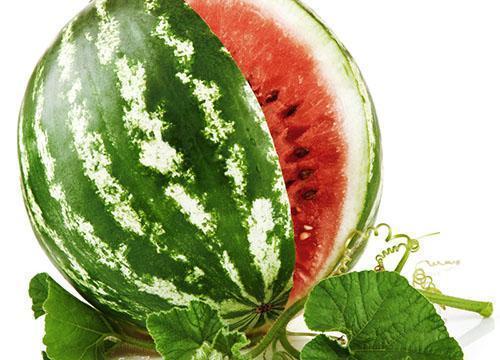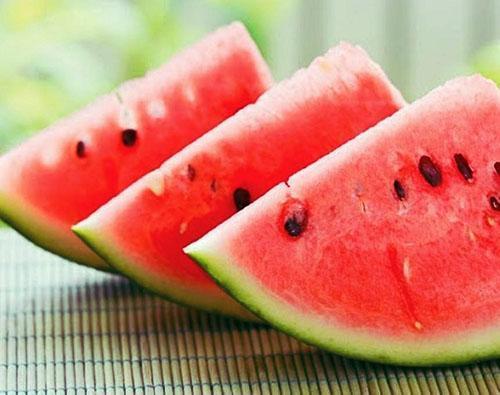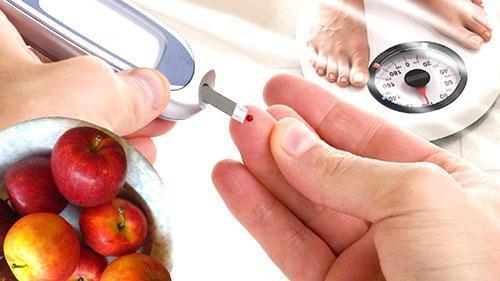Can you eat watermelons for type 1 and type 2 diabetes?
 Watermelon is a healthy dietary product. However, the presence of sugars raises doubts about the benefits of sweet berries for people with insulin dependence. Is it possible to eat watermelons with diabetes mellitus, and in what quantity, we will find out based on the specifics of the disease.
Watermelon is a healthy dietary product. However, the presence of sugars raises doubts about the benefits of sweet berries for people with insulin dependence. Is it possible to eat watermelons with diabetes mellitus, and in what quantity, we will find out based on the specifics of the disease.
Diabetes mellitus and diet

 There is type 1 diabetes, in which insulin is not produced at all. Such a person lives only on external feeding with the help of insulin injections. Closer to the slope of years, due to many factors, including obesity, the body's cells refuse to break down carbohydrates, despite the fact that insulin is produced in the body and is in the blood at the desired concentration. This is type 2 diabetes or non-insulin dependent.
There is type 1 diabetes, in which insulin is not produced at all. Such a person lives only on external feeding with the help of insulin injections. Closer to the slope of years, due to many factors, including obesity, the body's cells refuse to break down carbohydrates, despite the fact that insulin is produced in the body and is in the blood at the desired concentration. This is type 2 diabetes or non-insulin dependent.
It is impossible to cure diabetes mellitus, but it is possible with the help of weight loss and a strict diet to alleviate the patient's condition and the amount of medications taken. In order to understand whether it is possible for diabetics to have a watermelon, you need to understand the criteria for choosing foods for a diet. Diets for diabetics are prescribed based on two indicators:
- glycemic index (GI);
- bread index (XE).
The glycemic index is a relative unit. It allows you to judge how quickly nutrients are released in the form of carbohydrates, how soon they enter the bloodstream. In this case, it is not the calorie content of the product that is important, but its rapid or gradual entry into the blood. The activity of glucose, a pure carbohydrate, is taken as 100 units. This means that the blood sugar level from the use of glucose increases by 100%. However, there are foods that increase the sugar intake even more, such as dried apricots.
It is believed that the index means the body's response to food, regardless of quantity. But the amount affects the duration of the blood sugar and the amount of insulin needed to block. Therefore, for diabetics, overeating watermelon can be very harmful with certain symptoms.
 The Bread Index measures how much sugar is released into the bloodstream after eating foods that contain carbohydrates. The reference is a 1 cm piece of bread, cut from a standard roll and weighing 20 g. In order for such food in the body to be processed without increasing sugar, 2 units of insulin are required.
The Bread Index measures how much sugar is released into the bloodstream after eating foods that contain carbohydrates. The reference is a 1 cm piece of bread, cut from a standard roll and weighing 20 g. In order for such food in the body to be processed without increasing sugar, 2 units of insulin are required.
The daily XE norm for people:
- work related to physical activity - 25;
- sedentary work - 20;
- diabetics - 15;
- with obesity - 10.
The benefits and harms of drinking watermelon for diabetics
 Watermelon is a dietary product containing up to 10% sugar. However, the composition of sugars is represented mainly by fructose, and it is broken down without the participation of insulin. The limited inclusion of sweet berries in the menu is beneficial, since the body receives nourishment with minerals, folic acid and other significant elements. Drinking a large serving of watermelon at the same time can cause blood sugar to rise. And excess fructose will be stored as fat.
Watermelon is a dietary product containing up to 10% sugar. However, the composition of sugars is represented mainly by fructose, and it is broken down without the participation of insulin. The limited inclusion of sweet berries in the menu is beneficial, since the body receives nourishment with minerals, folic acid and other significant elements. Drinking a large serving of watermelon at the same time can cause blood sugar to rise. And excess fructose will be stored as fat.
To include watermelon in your diet, you should consult your doctor.For the balance of XE and GI, the diet is reviewed for a while, other products are excluded.
In this case, 135 g of watermelon is considered equal to 1 XE, 40 Kcal and has a GI of 75. This means that the use of watermelon increases blood sugar by 75%, and it should be eaten in small portions, 200 g each and up to 4 times a day. This only applies to type 1 diabetics.
 For non-insulin dependent patients, you can consume no more than 200 g of watermelon per day, while it is better to eat it with bread. An important indicator for those who monitor their weight is the high GI of the watermelon. This speaks of the rapid assimilation of the product and the accompanying feeling of hunger. The patient may develop stress from restricting food intake. Therefore, watermelon in type 2 diabetes mellitus is a food of concern. Type 2 diabetics cannot fight overweight, including watermelon in their diet.
For non-insulin dependent patients, you can consume no more than 200 g of watermelon per day, while it is better to eat it with bread. An important indicator for those who monitor their weight is the high GI of the watermelon. This speaks of the rapid assimilation of the product and the accompanying feeling of hunger. The patient may develop stress from restricting food intake. Therefore, watermelon in type 2 diabetes mellitus is a food of concern. Type 2 diabetics cannot fight overweight, including watermelon in their diet.
Research has shown that fructose is not harmless. Eating more than 90 g of it per day causes obesity, and its constant presence in the diet can provoke type 2 diabetes. These people have more appetite, which leads to overweight.
 Fructose, contained in a daily intake of 800 grams, does not require splitting. This means that 40 g of fructose does not need 8 units of insulin, based on XE. At the same time, the body receives useful substances from the pulp and is the most useful product from summer greens and fruits. However, a large amount of fructose threatens the opposite phenomenon - obesity, problems with heart activity. This has been proven by the latest research by scientists.
Fructose, contained in a daily intake of 800 grams, does not require splitting. This means that 40 g of fructose does not need 8 units of insulin, based on XE. At the same time, the body receives useful substances from the pulp and is the most useful product from summer greens and fruits. However, a large amount of fructose threatens the opposite phenomenon - obesity, problems with heart activity. This has been proven by the latest research by scientists.
The beneficial properties of watermelon pulp are:
- diuretics;
- removes cholesterol;
- strengthens the heart and liver;
- improves hematopoiesis and fluid circulation through the artery and vein system;
- cleanses the liver from obesity;
- cleans deposits on joints and atherosclerosis.
The saturation of the pulp with 14 elements necessary for the functioning of all body systems allows the use of fewer replacement medications. The magnesium present in the berry is vital for the patient. It soothes stress, improves heart function, and stops the deposition of salts in the form of stones. It also helps to eliminate cholesterol.
 Can diabetics eat watermelon processed products? You cannot drink juice precisely because of the concentrated composition of sugars. The use of nardek or watermelon honey is contraindicated. This processed product contains 90% sugars. Watermelon oil in the diet of patients is welcome. In this case, the product must be unrefined, first cold pressed.
Can diabetics eat watermelon processed products? You cannot drink juice precisely because of the concentrated composition of sugars. The use of nardek or watermelon honey is contraindicated. This processed product contains 90% sugars. Watermelon oil in the diet of patients is welcome. In this case, the product must be unrefined, first cold pressed.
An incurable serious illness dictates the nutritional program, but the body must receive the necessary substances. The menu can be changed, but take into account the advice of a nutritionist.